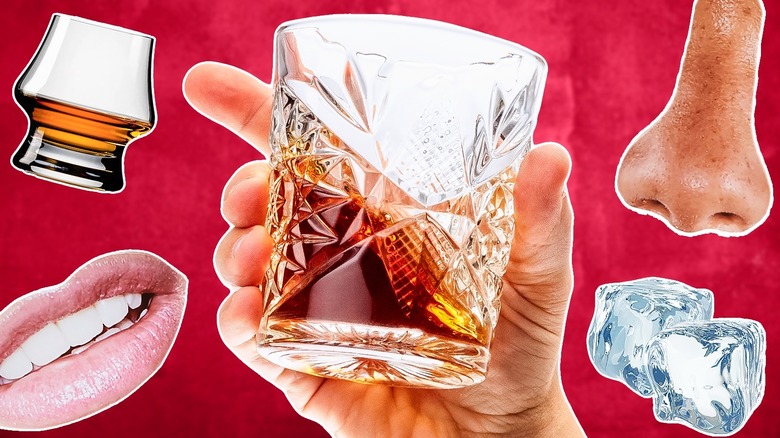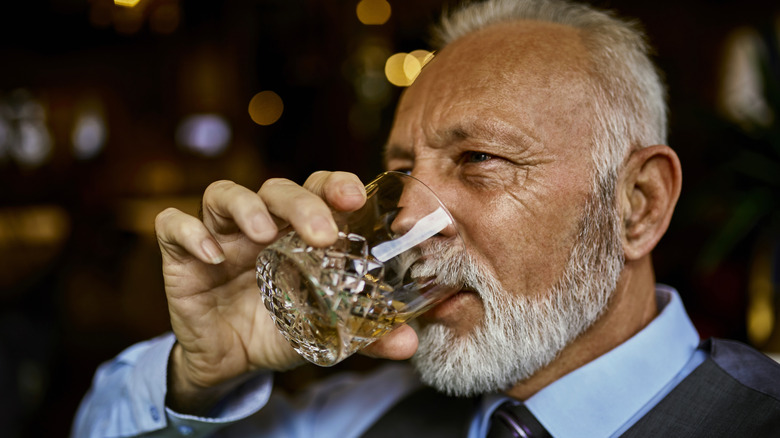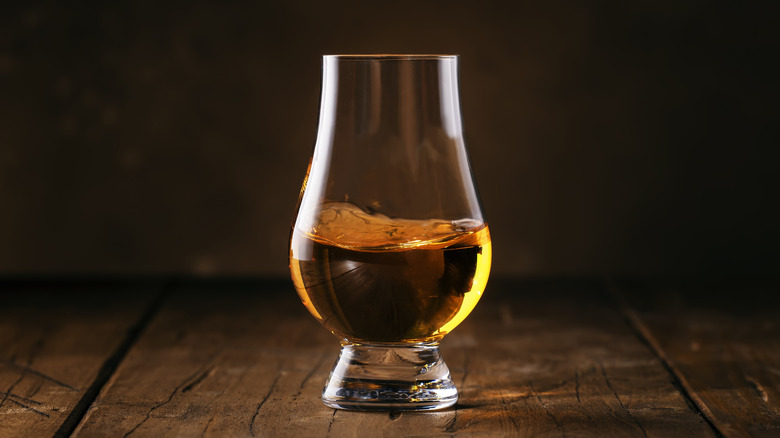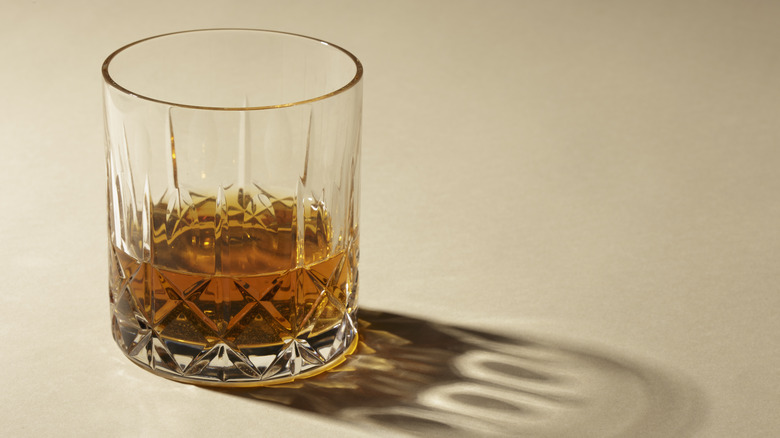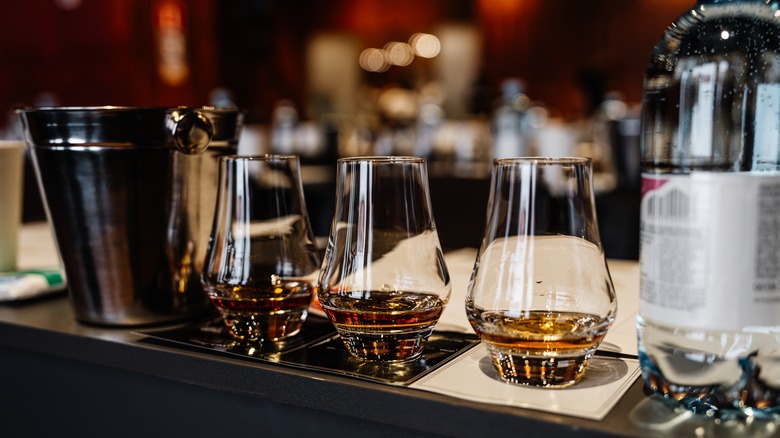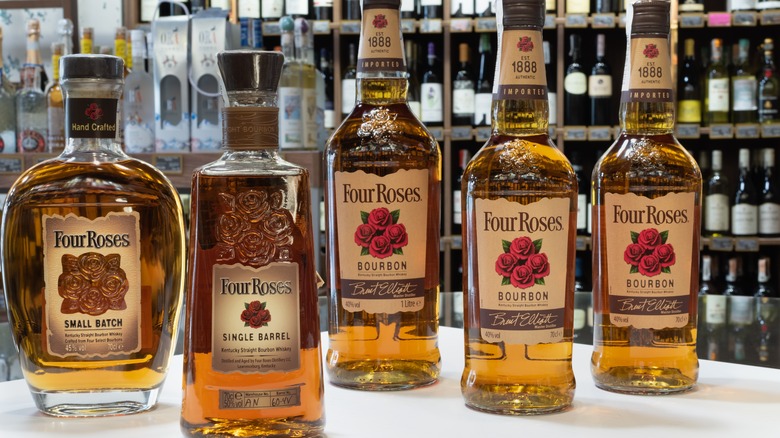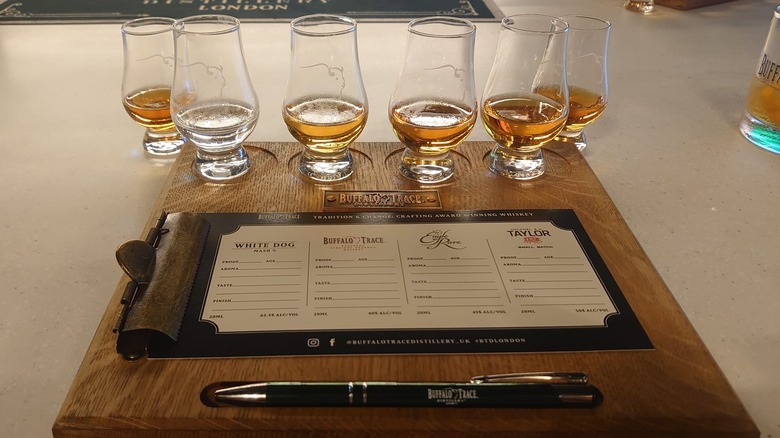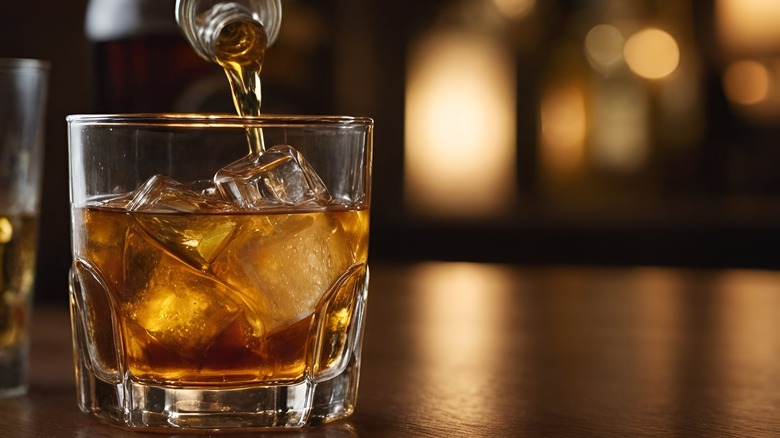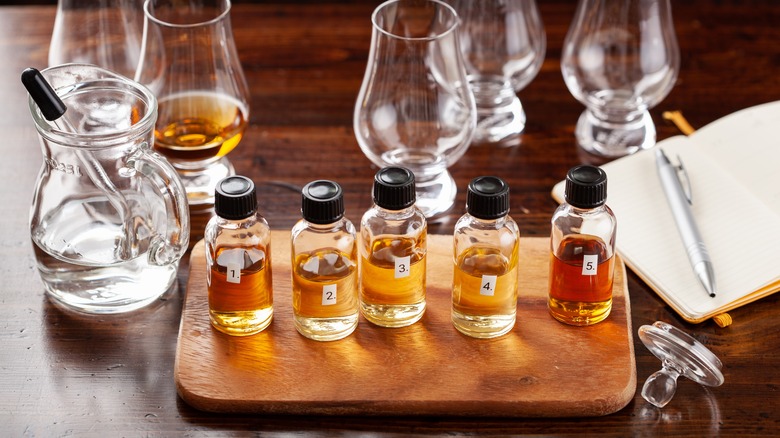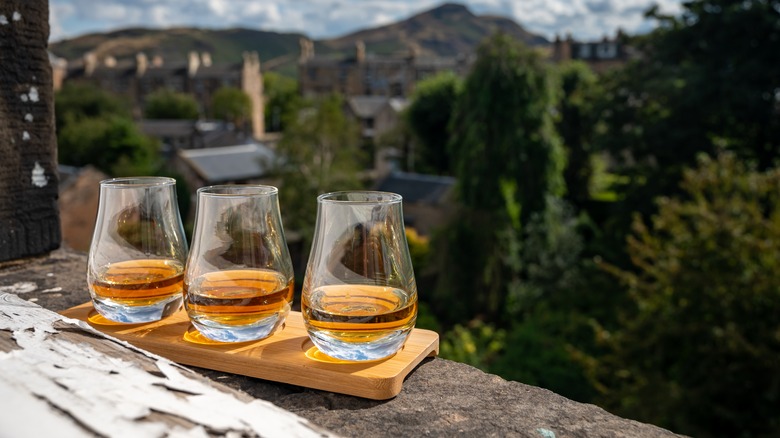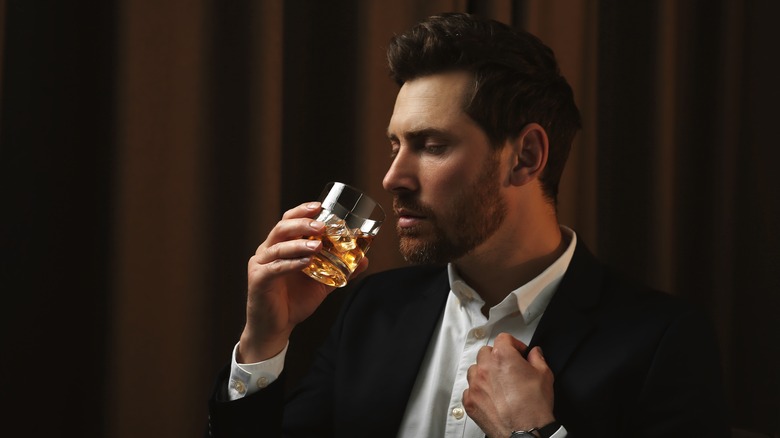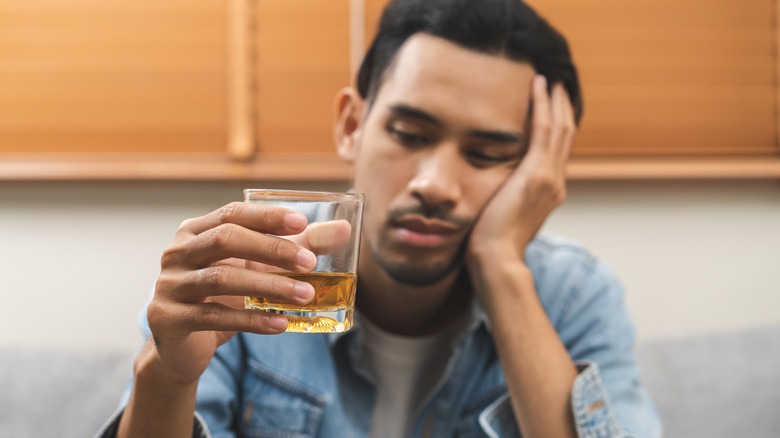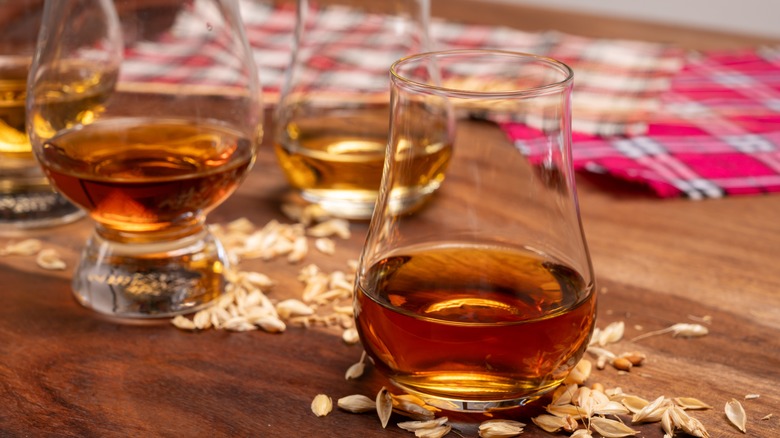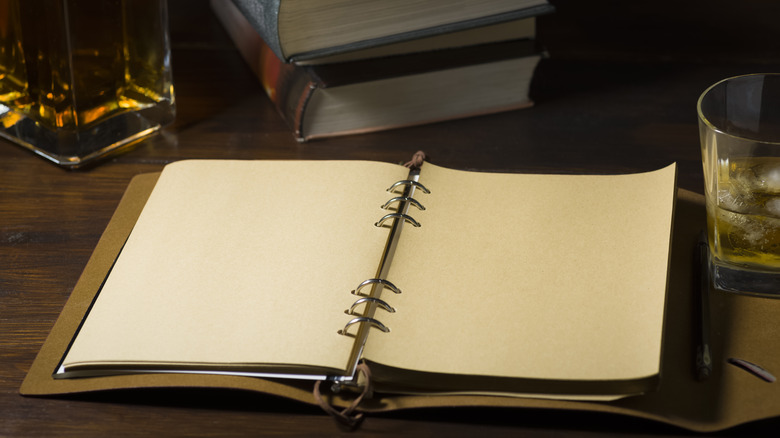14 Common Bourbon Tasting Mistakes That Are Easy To Make
You don't have to be a whiskey snob to appreciate good bourbon. However, there are some key mistakes that can affect your enjoyment of this fine spirit. That's why I wanted to come up with this list of all-too-common mistakes people make when sipping bourbon. These are blunders that every seasoned drinker has made in their tasting journey, so don't worry about feeling foolish; we've all been there.
I've been drinking bourbon for many a year and truth be told, I think I've made all of these mistakes at least once. Thankfully, that's all in the past, and I can now savor bourbon the way it was meant to be. The information I've gained isn't just based on my own experience, but also what I've learned from talking to other experts and on distillery tours, including a trip to Buffalo Trace in London. If you want to know the best way to enjoy a fine glass of bourbon, all you need to do is read on and enjoy the journey.
Taking too big a gulp
This is a classic mistake that can be made with any high-proof spirit. Maybe it's all too common because we see characters in movies and TV shows taking huge gulps of "whiskey" with no effect. In reality, there are very few people that can actually do that without negative consequences. Not only that, but it's also not the right way to enjoy bourbon. Taking a big gulp can be overpowering, and it's likely that you'll cough and splutter. If you still find yourself coughing at times, then make sure you take little sips instead. After all, there is no ego in drinking bourbon.
Not only that, but even if you can take a big gulp without coughing, there is too much bourbon in your mouth to pick out its rich array of flavors. A large gulp floods the palate and you're more likely to get a harsh, burning sensation. This can make you think the whiskey is bad, when in reality, you're just drinking it wrong. Great bourbon isn't a means to get drunk. It's a drink to be enjoyed, and that can only be done by taking your time with it.
Not using a tasting glass
I have mixed feelings when it comes to tasting glasses. I think they are the best way to sample bourbon, but I don't like drinking out of them for too long. Therefore, my advice would be to use a tasting glass for at least the first measure before moving on. A tasting glass is the perfect way to truly appreciate the aroma of a bourbon. It directs the aroma to your nose, which allows you to gently pick out all the different smells. As for the taste, the smaller opening reduces oxidation and helps to keep the bourbon true to the bottle.
The difference in tasting experience between a tasting glass and a tumbler is nuanced. However, once you've had experience with tasting a few bourbons, you'll notice the difference between them. Once I've appreciated the aroma and taste of a bourbon, then I'll move on to a larger whiskey glass. But I'll never open up a new bottle of bourbon and pour it into anything other than a tasting glass.
Overpouring your bourbon
You have a taste of your bourbon and enjoy it. The next step may be to pour your tumbler half full so you can sit there and enjoy your drink for a long time without needing to pour yourself another one. However, this would be a mistake. When it's exposed to the air, whiskey will start oxidizing. A little bit of this can be a good thing, but after a while, the flavors of the bourbon will start to dull. If you've ever tried a whiskey that has been left out overnight, you'll know how true this is.
Evaporation will also occur, which will alter the flavor and cause a taste imbalance. Finally, your whiskey is also more liable to contaminants, such as dust, insects, and your own saliva. Because of this, that beautiful bourbon that you enjoyed on the first sip won't taste quite as nice on the last one. To fully appreciate bourbon's complexity, it's always best to pour a modest amount that you can finish within half an hour at the most. Instead of overpouring, just keep that bottle of bourbon close by and pour less bourbon per glass.
Not having a clean palate
The order in which we consume foods can have a big influence on how we perceive flavor. The best example of this would be eating something directly after brushing your teeth. In a similar way, if you eat something with a dominant flavor, it can interfere with your taste buds and prevent you from picking out both subtle and complex tasting notes in your bourbon. The worst culprits are anything with a strong taste – including garlic and spicy foods. Not only does the flavor linger on your palate, but it's also hard to get rid of.
If you're trying a new bourbon, you'll want to be sure you start with a clean palate so you don't distort your perception of the drink's true flavor profile. The best thing you can do is to eat plain carbohydrates, such as plain bread and crackers. Watery fruits, such as apples and watermelon, are also good options. Even if you don't eat anything with a strong flavor, it's a good idea to cleanse your palate with still water. Of course, if you're drinking a bourbon you've had countless times before, it's not much of an issue; the true whiskey taste will come through eventually. But if you want to truly savor a bourbon, you need to give it a blank canvas so it can paint its masterpiece.
Skipping the research
Okay, here I'm drifting into snobbery, but I'm a big believer that understanding the history of your drink can play an important role in the tasting experience. Bourbon is a product of craftsmanship, history, and tradition. There is a unique story behind almost every distillery, with Four Roses being one of many such examples. Before enjoying your whiskey, it's good to know about the distillery's heritage, the aging process, and the mash bill used. For example, some bourbons are made with a high percentage of rye, while others use more wheat. Plus, each distillery will vary in the the amount of corn it uses.
Not only does this aid in the experience, but it helps to give you expert knowledge when you go to compare your drink to other bourbons. Knowing its history somehow makes each sip more meaningful. You'll appreciate what went into making the whiskey and why it deserves to be treated with respect. Even if you don't want to spend time reading reams of information about your bourbon, even knowing the basic information can make the experience all the more informative. Most of the time, this information is right there on the bottle. Once you've learned these nuggets of information, you'll find joy in teaching other bourbon enthusiasts about what they are drinking.
Following tasting notes
Have you ever had a moment where someone has asked you if you can smell something, but you only noticed it after it was mentioned? The same thing can happen with bourbon on both the nose and the palate. Relying on other's tasting notes can influence your own tasting experience. This isn't the worst thing in the world, but there is joy in finding your own tasting notes. You'll build up your experience and expertise as you try and work out the aroma and the taste of every bottle you sample. Eventually, you'll become adept at discovering and separating the most common tasting notes in bourbon.
There is great fun in speaking to others and comparing notes, but it's best done after you've developed your own thoughts. You can then understand different perspectives and discuss the pros and cons of the bottle. Looking at tasting notes before you've taken a sip can also lead your opinion of the bottle in a certain direction. Everyone's palate is unique, and two people can get different tasting notes from the same drink. Giving yourself time to smell and taste allows you to have a genuine and unbiased opinion. Finally, ignore any "experienced" bourbon drinker who says your tasting notes are wrong. Your tasting experience is just as valid as anyone else's.
Including ice on the first try
I'm someone who drinks bourbon neat 99% of the time. However, that is not the "right" way to enjoy bourbon, as there is no "right" way. Many others prefer it on the rocks, and there is no problem with that. But I feel there's value in enjoying bourbon in its purest form. Ice can alter your tasting experience because it can hide some of the subtle tasting notes. If you want to truly appreciate bourbon, then you should put the ice to one side for a moment. Enjoy it neat, at room temperature, in a tasting glass.
Even if it's a small measure before you move on to a tumbler with ice, good bourbon deserves at least one shot (mind the pun) as it comes out of the barrel. Even whiskey stones can alter the flavor. Although it doesn't dilute your beverage, certain flavors can be muted because of the colder temperature. Personally, I've found it most affects subtle fruity and earthy flavors. Added to that, common notes of vanilla and caramel won't be as defined. To truly appreciate the depth and richness of a well-crafted bourbon, have it neat, at least once, please.
Not adding water
"But you just said" — I hear you cry! Even though I think bourbon should be tasted neat on the first sip, that doesn't mean you shouldn't experiment with it. There are some of what I'd call "intermediate-level bourbon drinkers " that think adding water is a sin. The reality is that many whiskeys, unless they're bottled at barrel proof, have already been watered down. It's important to note that distilleries do this with the same pristine water they make the bourbon with.
Even for an expert like myself, high-proof bourbon can dominate the palate. It can take a few sips before the true flavor presents itself. I always like to add a little water to high-proof whiskey after I've jotted down my initial tasting notes. This is because it can release extra aromas and flavors that were hidden by the high alcohol content. What's magical is that when you go back to drinking it at full strength, these flavors suddenly become more apparent. As for what water to use, opinions vary. Some say distilled, as it doesn't introduce new flavors, whereas others say spring water, as that is what a lot of whiskey is made from. Personally, I've always found spring water to be perfectly acceptable, as the mineral content doesn't conflict with the nuances of the bourbon.
Not letting it breathe
Letting a whiskey breathe means letting it sit in the glass for a little while before drinking it. When you first pour your bourbon, harsh alcohol vapors can linger and overpower more subtle aromas and flavors. Allowing it to sit for a few minutes allows these to dissipate and makes for a more enjoyable experience. Exactly how long you should wait is debatable. Some have argued that you should wait one minute for every year of aging.
Given that even good bourbon commonly lacks an age statement, I find this ratio to be both tiresome and difficult. It's my belief that you should let bourbon sit for a minute or two after pouring, regardless of age. Smelling and tasting it immediately after pouring it can be a shock to the nose and palate. It's a great idea to experiment with this yourself and find your perfect resting period. Giving your bourbon a chance to breathe can lead to a more balanced tasting experience.
Skipping the nose
You shouldn't forget to smell bourbon before giving it a taste. I personally rate aroma very highly when it comes to the overall tasting experience. I've never known of any bourbon lover who enjoys the taste but not the smell of the alcohol. They are intrinsically linked and are often indicative of each other. That means that if the whiskey smells great, there is usually a fantastic drink to follow. When opening a new bourbon, I often feel a buzz of excitement when a range of beautiful smells hit my nostrils. I know whatever I've bought is going to be worth the money.
Before drinking, I'll often sample the aroma three or four times. It's part of the richness and depth of the beverage and is vitally important. I've been to many distilleries, and they are usually just as enthusiastic about the smell as the taste. If you skip the nose, then you're missing out on a key piece of the jigsaw puzzle.
Great bourbon is nuanced and delicate. Take a gentle breath in through the nostrils on the rim of the glass to enjoy the experience.
Tasting high-quality bourbon at the wrong time
Bourbon will indeed get you drunk. But where comes a point where you shouldn't waste your money, or the craftsmanship, if you're just looking for buzz. If I'm being honest, this mistake depends on the situation. If you're drinking cheap bourbon with a mixer, then how you drink it isn't really important. However, mindlessly taking sips from a great bourbon is a mistake.
If you have a finely crafted bourbon in front of you, then you should stop drinking it as soon as you stop appreciating it. There is a point of drunkenness where I stop having the good stuff, as it is just wasted. Some bourbon is cheap enough to be sipped on at every occasion, but decent bottles are there to be savored. To account for this, I make sure my cabinet is full of different bourbons. Learning when to put that good bottle away takes experience.
Ignoring the finish
The amount of time that a flavor lingers in your mouth is a big predictor for how much you'll enjoy a food or drink. Likewise, the finish can make or break a bourbon. If you've ever had bottom-shelf whiskey, then you'll already know all about the finish. Bad bourbon has a harsh aftertaste that gets stuck in your throat. In comparison, great bourbon transforms that harsh aftertaste into an elegant warmth and brings out flavors that you may not have noticed when you were sipping on it.
It's on the finish where the spiciness of the whiskey will further present itself. You can also find other earthy notes, such as smokiness and oak. It's easy to presume that the tasting experience is finished after you swallow the bourbon, but it's not true. The remnants of the spirit still have a few stories to tell. Paying attention to the finish will allow you to fully understand the bourbon's profile. If you loved the aroma and the palate hits all the right notes, it only makes sense that the great finish is like the perfect way to end your sip. It ties everything together and gives you the ultimate satisfaction.
Judging too quickly
You take a sip, and you're not impressed. At this point, it can be easy to write off the bourbon and jot down your tasting notes. I have never got the full picture from a bourbon on the first sip. That being said, if you're going in without a clean palate or you're overwhelmed by the proof, you may go into your tasting with misleading expectations.
Bourbon will only reveal its true complexity after a few sips. The initial taste will give you the most dominant flavors, but the more nuanced notes can take a while to emerge. If I'm drinking bourbon at a bar, I like to take a small sip and let it coat my mouth. I'll then continue with the small sips until I feel I'm ready to truly appreciate what I'm drinking. There have even been times when I've put a bottle away for another time because my palate wasn't quite right. Give a bourbon a few chances before you write it off.
Not making a note
A fun part of the bourbon experience is being able to compare your whiskey against others that you've tasted in the past. Unless you have an incredible memory, it's easy to lose track of the bourbons you've tried, along with your tasting notes. Whether it's a notebook, a spreadsheet, or something else, I think it's a great idea to keep track of the bottles you liked and the ones you didn't. It gives you a great reference point for future tastings and allows you to expand your bourbon knowledge. Not only that, but it enhances your current experience, as it will focus your mind on the details of the bourbon you're currently enjoying.
When doing this, it's a good idea to jot down some key information along with your tasting notes, such as the cost, location you purchased it, and any other relevant notes. I give separate scores for the aroma, palate, and finish. It's a simple, rewarding habit and one that you'll love looking back on when you've tasted a wide range of bourbon. This is, of course, not an essential task. But, for me, part of the fun of being a bourbon lover is adding yet another line to my spreadsheet and looking at how its score relates to others.
